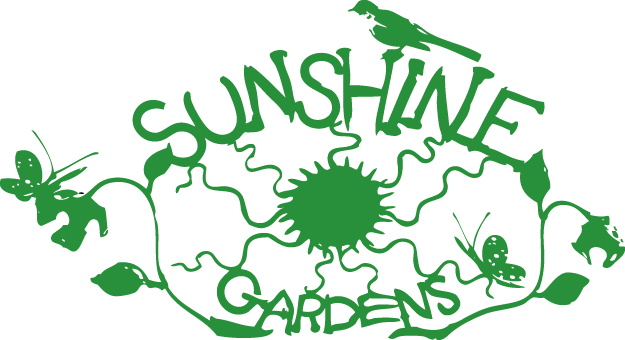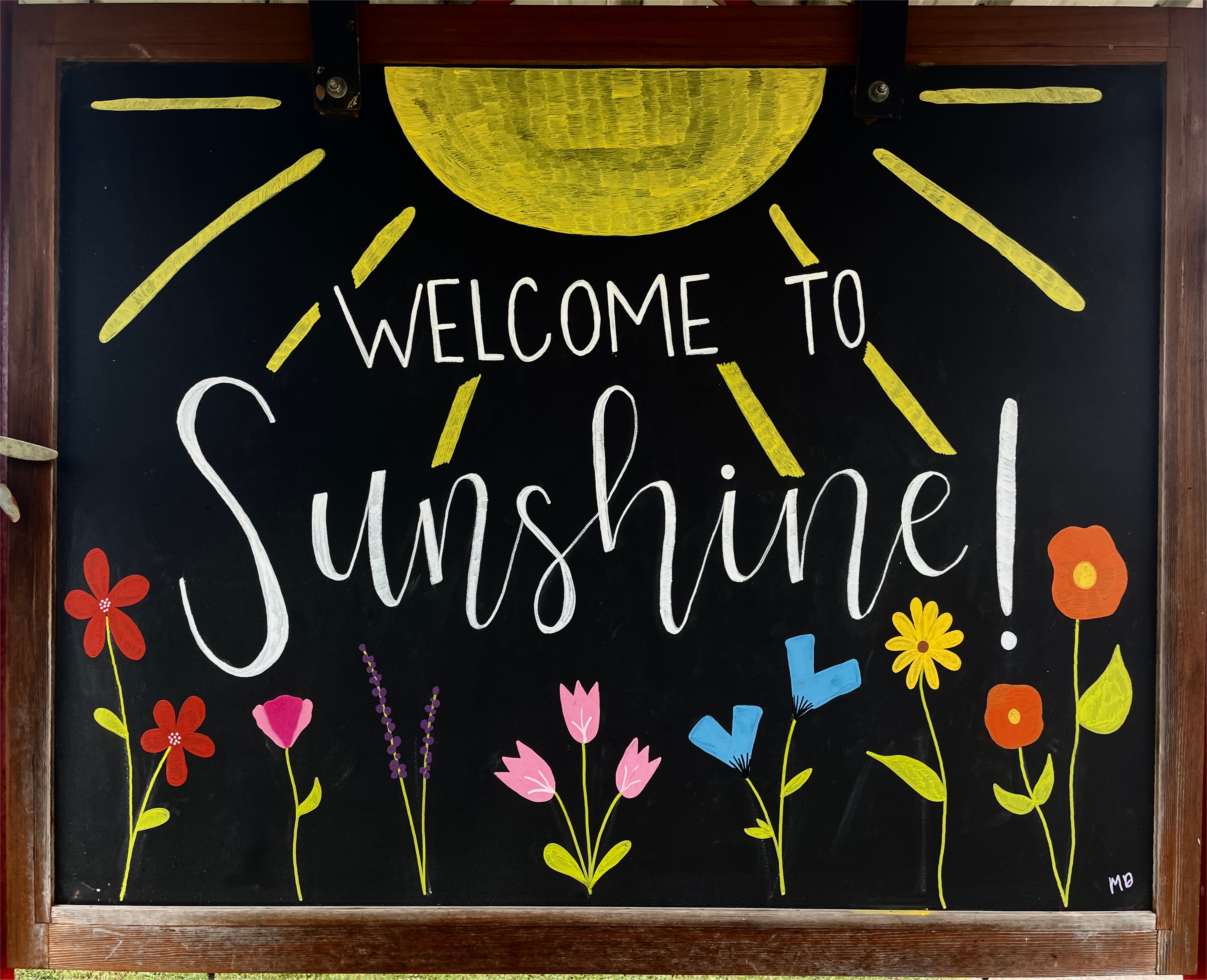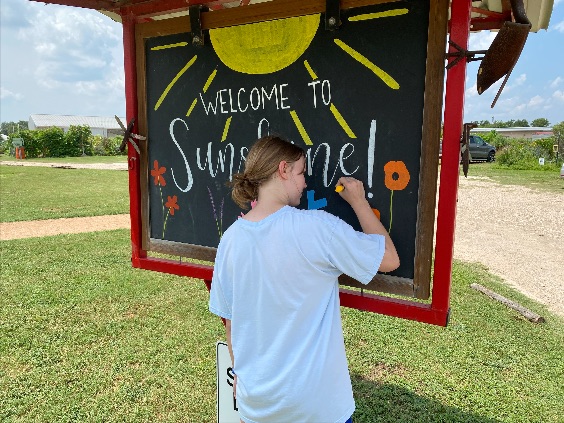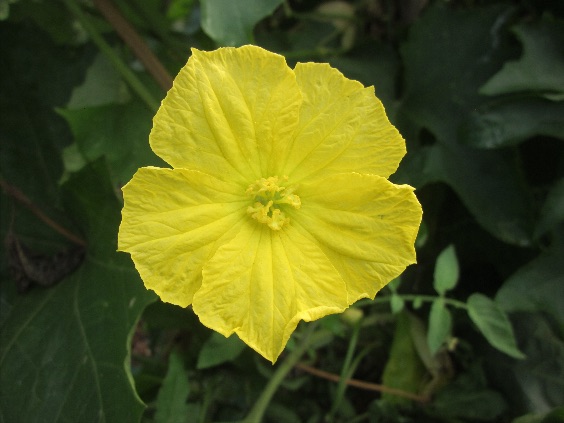
5 August, 2021
www.sunshinecommunitygardens.org
If you are signed up to receive the Weekly Weeder and have not been receiving it, here is a troubleshooting page to help. If this doesn't help, please let Sharon at scgardenweb@gmail.com know. Thanks.
In this Issue:
- Sunshine Has a New Welcome Sign!
- Sunshine Following CDC Masking Guidelines
- August Garden Resources
- Photo: Lovely Luffa Blossom
- Micah 6 Food Pantry Totals for July
- Garden Tasks for Service Hours
New Welcome Sign Graces Garden
The kiosk on Sunshine's front lawn has a new sign welcoming gardeners and visitors to Sunshine!
The sign was designed and painted by Jim Willmann's granddaughter, Megan. Thank you Megan for the beautiful, colorful sign!
Sunshine Following CDC Masking Guidelines
Sunshine is following the Center for Disease Control's masking guidelines. CDC modifies those guidelines periodically based on the status of the Covid virus. Gardeners are urged to stay familiar with the CDC's current guidelines and follow them at Sunshine.
Based on current guidelines gardeners should wear a mask in the trailer and in the tool shed. Thank you for doing your part to help protect others in our community.
Resources for Your August Garden
Normally August in Austin can be brutal, and many gardeners may need limit how much time they spend in the heat. But happily this year the August forecast is a bit cooler than usual! There are several things that may be planted in August--especially later in the month-- and it is an ideal time to start preparing for Fall Gardening. Below is a list of vegetables to plant this month in Travis County (from the Texas A&M AgriLife Extension Vegetable Garden Planting Guide) and an excellent article on the August Garden by Patty G. Leander, submitted to the Weeder by Ila Falvey.
Vegetables to Plant in August:
Beans, Snap and Lima (Seeds; Starting mid-August)
Beets (Seeds; Starting last week of August)
Broccoli (Transplants; Starting last week of August)
Brussels Sprouts (Transplants; Starting last week of August)
Cabbage (Transplants; Starting last week of August)
Carrots (Seeds; Starting last week of August)
Cauliflower (Transplants; Starting last week of August)
Chard (Seeds or Transplants; Starting last week of August)
Collards (Seeds or Transplants; Starting last week of August)
Corn (Seeds; Now through mid-August)
Cucumber (Seeds; All Month)
Eggplants (Transplants; Now through mid-August)
Greens, Warm Season (Seeds; Now through mid-August)
Kohlrabi (Seeds or Transplants; Starting last week of August)
Mustard (Seeds or Transplants; Starting last week of August)
Okra (Seeds; Now through mid-August)
Peas, Southern (Seeds; Now through mid-August)
Pepper (Transplants; Now through mid-August)
Potato, Irish (Potato Pieces; Starting mid-August)
Squash, Summer (Seeds; All Month)
Squash, Winter (Seeds; Now through mid-August)
Tomato (Transplants; Now through mid-August)
Turnip (Seeds; Starting late August)
In the August Garden with Patty Leander
(Note: This article was posted on the Travis A&M AgriLife Extension's "Extension Education in Travis County" web page. This page includes photos and links to additional resources.)
Transition Time in the August Vegetable Garden
August is a transitional time in the vegetable garden as we clean up the remnants from summer and plan and prep for the milder days that will come. The first frost in Central Texas usually arrives in late November or early December which means we have over 3 months of frost-free weather ahead. Many gardeners concentrate on the array of cool season vegetables that thrive in fall's cooler temperatures though there is also time for a fresh planting of green beans, cucumbers and squash, which start producing about two months after sowing seeds.
Create your Fall Gardening Plan
The size of your garden and what you like to eat will largely determine what you decide to plant. Think about the space each vegetable requires to reach harvest size, sketch your plan for fall and check the Vegetable Garden Planting Guide for recommended planting dates. It may seem counterintuitive to start planting during the hottest and driest time of the year but if you wait until the temperature is just right, which could be October or even November, that first frost could damage young or tender plants. In spring we plant early and protect our plants from cold weather and high winds and in fall we plant early and protect our plants from excess heat and blazing sun. That's gardening in Texas!
August Vegetable Garden Checklist:
Water
- Be sure to watch the forecast and turn off automatic sprinklers or timers if rain is in the forecast.
- Water new seedlings regularly; direct sun combined with high temperatures can be a death sentence for a tender seedling without an established root system
- Water container plants often, daily if needed, to provide sufficient moisture.
Soil/Mulch
- In preparation for planting spread a 2-inch layer of compost over garden beds and mix it in lightly. Water the area well before planting seeds or transplants.
- A layer of mulch is an important component for the vegetable garden; it moderates soil temperature, deters weeds, helps conserve moisture and gradually breaks down and enriches soil. Dried grass clippings, leaves, organic straw, partially decomposed compost and shredded bark are suitable options.
Fertilize
- As tomatoes, eggplants and peppers begin to flower and form fruit give them a boost with an application of water-soluble fertilizer according to label directions. If using a granular garden fertilizer spread 1-2 tablespoons around the base of each plant, scratch it in lightly and water well.
Plant/Transplant
- Shade young seedlings and transplants from direct afternoon sun. Use what you have on hand - an old window screen, shade cloth, sheets, cardboard or umbrellas. Get creative. It isn't permanent and it doesn't have to look pretty but it will give your plants a fighting chance.
- If you have decided to grow green beans, squash or cucumbers plant seed in late August or early September. For best results choose varieties that mature in less than 60 days and be prepared to water regularly until they are established.
- Take into account that milder temperatures and shorter days will slow the growth of fall plantings.
Diseases/Pests
- Watch for aphids on tender leafy growth; they can be easily dispatched with a strong spray of water.
Harvest
- Thanks to generous rains and milder temperatures in July many gardeners are still harvesting good-looking tomatoes. Make the most of the bounty by freezing, canning, oven-roasting or dehydrating.
- Pick peppers, eggplant and okra frequently. Okra pods should be picked when they are about 3-5 inches long and still tender.
- Eggplant should be shiny and firm, and most peppers can be consumed whe n green or can be left on the plant to mature to red, orange, purple or yellow, depending on variety.
- Southern peas can be harvested when pods are immature and peas are tender or pods can be allowed to dry completely on the vine, then peas can be shelled and stored for delicious and nutritious winter meals. Either way be sure the pods make it to the compost pile.
Maintenance
- Pull or hoe weeds around the vegetable garden - they compete with young plants for water and nutrients. Green, leafy weeds are an excellent nitrogen source for the compost pile.
- Prune out dead stems and rangy growth of thyme, oregano, sage and other perennial herbs.
Tips
- If possible, garden during the mornings or evenings. If you must be outside during the hottest time of the day apply sunscreen, wear a wide brim hat, stay hydrated and take frequent breaks.
- Mosquitoes can be a major pest, especially with July's unseasonable wet weather. Eliminate breeding grounds by cleaning out any sources of standing water and treat water in birdbaths and rain barrels with a product containing Bacillus thuringiensis israelensis (Bti). When working outside wear loose fitting, light-colored long sleeves and long pants and spray clothing with a repellent containing DEET or oil of lemon or eucalyptus. A mosquito hat or head net, found at camping stores or online, can be very effective at keeping mosquitoes away from the face.
About the Author:
Patty G. Leander is a contributing writer for Texas Gardener magazine and an active member of the Travis County Master Gardeners Association with an Advanced Master Gardener specialty in vegetables. She has been growing vegetables year-round in her Austin garden for over 20 years, encouraging the use of sound, horticultural practices that will lead to a bountiful harvest.
Micah 6 Update: July's Excellent Totals
Micah 6 Food Pantry thanks Sunshine gardeners for your continued generosity. Walter Kuhl notes the amount of produce and dry goods (dry beans, rice, canned goods) donated is impressive and very much appreciated. The donation totals will be published each month in the Weekly Weeder so everyone can see the good work being done by Sunshine gardeners.
July Donations:
- Produce - 1002.75 pounds
- Dry Goods - 64 pounds
Year to date totals:
- Produce - 3002.5 pounds
- Dry Goods - 215 pounds
Virtually 100% of the produce delivered to the food pantry is taken by food pantry clients. That said, almost weekly we've had oversized, inedible okra donated to Micah 6. In general okra should be harvested when around 3 - 5 inches. Usually okra 6 inches or longer is too fibrous to be eaten. Thank you for making a difference!
Needed Service Hour Tasks - August 4, 2021
To help keep gardeners aware of what service hour tasks are needed, an attempt will be made to keep this list current.
A huge THANK YOU to everybody that showed up for our work day on Saturday! You made a difference!
Please observe our 3 mph speed limit! The garden road is not a ranch road!
Priority (Tasks specifically needed):
- Digging up khaki weed, wherever you find it (Counts as TSVBI hours).
- Maintaining common paths and common areas. If you have plants extending into common paths, trim them. The common paths are designed to allow the biggest wheelbarrows that we own to traverse them unimpeded.
- I know that mowing is mentioned three times below, but it really can't be mentioned too much. We're in the process of purchasing a new battery powered mower which will help make a difference only if folks use it. A short orientation will make it, along with our battery powered weed eaters, available for gardeners use. Please contact VP Steve Camp (campinthegarden@yahoo.com) for info.
TSBVI:
- Removing hackberries and Johnson grass growing in cyclone fence around Sunshine. (Please try to dig out as much of the roots as possible. Hackberries should be cut off as deep below ground level as possible.)
- Weeding paths in TSBVI garden and wood chip areas on west side. (This is normally needed. Try to get out roots. Be sure to smooth out paths after weeding to facilitate TSBVI students moving around garden.)
- Mowing between fence and street along 49th St. and Sunshine Dr. along and 10' inside fence. (Frequent mowing will be needed this timeof year.)
- Picking up trash in compost area and along fencelines.
- Cleaning street curb gutters of dirt and debris build up. (At places in the curb gutter along Sunshine Dr. and 49th St., soil and debris has built has up and grass beginning to grow. Scrape off with shovel and put in wheelbarrow. If debris is gravel, can be put in low places in parking lot. Otherwise, put in dumpster.)
Regular:
- Mowing (Please check area around trailer and greenhouses. Frequent mowing will be needed this time of year.)
- Maintaining common paths. (Gardeners are required to maintain a 2' strip of common paths adjacent to their plot.)
- Mowing and cleaning up overgrown/messy places in common areas.
Note: TSBVI hour tasks can also count as regular hours.
Weeder Content
Please submit
weekly weeder articles, photos, and recipes by Wednesday to both Co-Editors:
Holly Gilman at hollyjgilman@gmail.com and
Maria Beach at dr.maria.beach@gmail.com
Officer and Zone Coordinator Contacts - Sunshine Gardens
Officers
- President - James "Jim" Willmann jhwillmann@gmail.com
- Vice-President - Steve Camp campinthegarden@yahoo.com
- Secretary - Kerry Drake kerryadrake@gmail.com
- Treasurer - Debra Marino scgtreasurer1@gmail.com
- Director - Kay McMurry scg.plots@gmail.com
- Director - Marsha Riti marshariti@gmail.com
- Director - Doug Zullo dugzoo@gmail.com
Email the board.
Zone Coordinators
- Zone 1, Susan Wallar swallar@gmail.com
- Zone 2, Wayne Kuenstler wckuenstler@gmail.com
- Zone 3, Ludmila Voskov lvoskov@austin.rr.com
- Zone 4, Ila Falvey ila.falvey@gmail.com
- Zone 5, Mary Gifford mgifford@austin.rr.com
- Zone 6, Charlotte Jernigan charlotte@cybermesa.com
- Zone 7, Jeff Schulz chilihead.schulz@gmail.com
- Zone 8, Steve Uecker steven_uecker@hotmail.com
- Zone 9, Kerry Howell casonhowell@gmail.com
- Zone 10, Christopher Schroder
christopher.s.schroder@gmail.com &
Karl Arcuri karl.w.arcuri@gmail.com
Other Personnel
- Weekly Weeder Newsletter - Holly Gilman hollyjgilman@gmail.com
- Weekly Weeder Newsletter - Maria Beach dr.maria.beach@gmail.com
- Plant Sale - Randy Thompson & Janet Adams jartdaht@gmailcom
- TSBVI Liaison & Volunteer Coordinator - TBA
- Plot Assignment - Kay McMurry scg.plots@gmail.com
- Compost Coordinator - Janet Adams jartdaht@gmail.com
- Carpentry & Repairs - Robert Jarry r.jarry@sbcglobal.net
- Water Leak Repairs - Steve Schulz sschulz784@aol.com
- Tools & Wheelbarrows - Bob Easter bob@easterandeaster.com
- Gas Mowers - Ray Porter Gasmowers@icloud.com
- Cordless Mowers/Trimmers - Steve Camp stcole431@yahoo.com
- Kitchen Supplies - Anita Keese
anodekraft1@msn.com
(If supplies are needed for events, contact by email or at 512-773-2178) - Compost Tea -
- Micah 6 - Dana Kuykendall kuykendall@austin.rr.com
- Micah 6 - Mary Gifford mgifford@austin.rr.com
- Micah 6 - Walter Kuhl kuhlwalter088@gmail.com
- Website Coordinator - Sharon Rempert scgardenweb@gmail.com
Record Service Hours Online - Green Binder
Garden Thoughts
Calendar
Ongoing
Board Meetings
Second Tuesday of every month.
Copyright © 2025 Sunshine Community Gardens
Location: 4814 Sunshine Dr. Map
Mailing Address: Sunshine Community Gardens, P.O. Box 302349, Austin, TX 78703-0040







